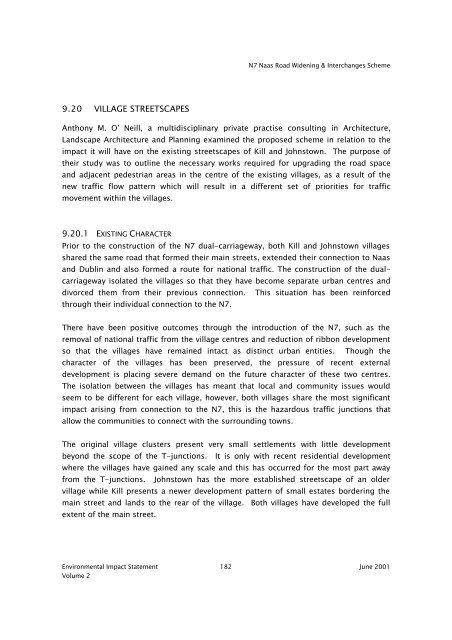Volume II - Kildare.ie
Volume II - Kildare.ie
Volume II - Kildare.ie
You also want an ePaper? Increase the reach of your titles
YUMPU automatically turns print PDFs into web optimized ePapers that Google loves.
9.20 VILLAGE STREETSCAPES<br />
N7 Naas Road Widening & Interchanges Scheme<br />
Anthony M. O’ Neill, a multidisciplinary private practise consulting in Architecture,<br />
Landscape Architecture and Planning examined the proposed scheme in relation to the<br />
impact it will have on the existing streetscapes of Kill and Johnstown. The purpose of<br />
their study was to outline the necessary works required for upgrading the road space<br />
and adjacent pedestrian areas in the centre of the existing villages, as a result of the<br />
new traffic flow pattern which will result in a different set of priorit<strong>ie</strong>s for traffic<br />
movement within the villages.<br />
9.20.1 EXISTING CHARACTER<br />
Prior to the construction of the N7 dual-carriageway, both Kill and Johnstown villages<br />
shared the same road that formed their main streets, extended their connection to Naas<br />
and Dublin and also formed a route for national traffic. The construction of the dual-<br />
carriageway isolated the villages so that they have become separate urban centres and<br />
divorced them from their previous connection. This situation has been reinforced<br />
through their individual connection to the N7.<br />
There have been positive outcomes through the introduction of the N7, such as the<br />
removal of national traffic from the village centres and reduction of ribbon development<br />
so that the villages have remained intact as distinct urban entit<strong>ie</strong>s. Though the<br />
character of the villages has been preserved, the pressure of recent external<br />
development is placing severe demand on the future character of these two centres.<br />
The isolation between the villages has meant that local and community issues would<br />
seem to be different for each village, however, both villages share the most significant<br />
impact arising from connection to the N7, this is the hazardous traffic junctions that<br />
allow the communit<strong>ie</strong>s to connect with the surrounding towns.<br />
The original village clusters present very small settlements with little development<br />
beyond the scope of the T-junctions. It is only with recent residential development<br />
where the villages have gained any scale and this has occurred for the most part away<br />
from the T-junctions. Johnstown has the more established streetscape of an older<br />
village while Kill presents a newer development pattern of small estates bordering the<br />
main street and lands to the rear of the village. Both villages have developed the full<br />
extent of the main street.<br />
Environmental Impact Statement 182<br />
June 2001<br />
<strong>Volume</strong> 2
















